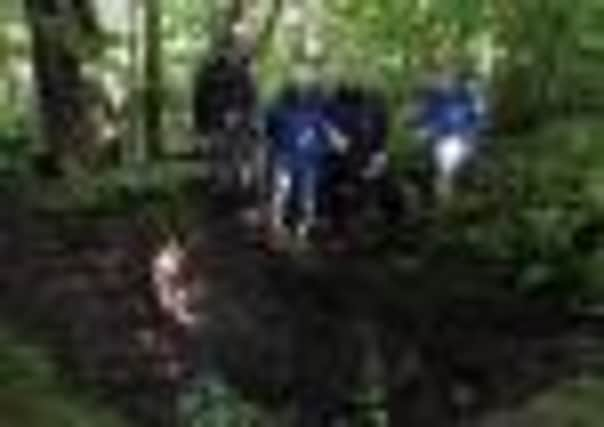News joins bid to preserve First World War training trench site


The only clue to their importance is a shard of metal poking up from the bottom of one of the ditches.
This is one of the last remnants of a piece of Edinburgh’s First World War history, where young men got their first taste of life in the trenches before being shipped overseas, many never to return.
Advertisement
Hide AdAdvertisement
Hide AdSoon, what is left of the former training trenches could be lost for ever, swallowed up by nature.
But now moves are under way to save one of the most poignant pieces of the Capital’s military history.
It is estimated that just £10,000 will be enough to save the trenches, keeping them as a memorial to those who died overseas and a place where local schoolchildren can learn at first hand about what the fighters had to endure.
The campaign, which has the full support of the Evening News, is being led by writer and historian Lynne Gladstone Millar, whose father trained in the trenches before he was sent to the Western Front.
Advertisement
Hide AdAdvertisement
Hide AdWilliam Ewart Gladstone-Millar – or “Glad” as he was nicknamed – was one of only two students from his final year at university to survive the Great War.
This week, representatives from Historic Scotland, the Ministry of Defence and the city council met to discuss the way forward.
Ms Gladstone-Millar said: “I am at a loss as to why are the trenches are not considered as an important part of our heritage and therefore valued by the city – or indeed the army. They are being lost to nature.
“Originally, they would have been 6ft deep but now they have begun to fill up with silt and leaves. There are trees growing in the middle of them.
Advertisement
Hide AdAdvertisement
Hide Ad“But there is still time to have them cleared out and they could prove an excellent educational tool for children.
“The value of the trenches has not been appreciated – they bring the history of the First World War alive.”
The area of Dreghorn Woods where the trenches lie is open to the public and is in the ownership of the Ministry of Defence.
In October 2009, a set of Second World War trenches found near Invergordon was described as an important discovery by the Royal Commission on the Ancient and Historic Monuments.
Advertisement
Hide AdAdvertisement
Hide AdMs Gladstone-Millar said: “When I heard about the trenches at Invergordon, I thought to myself: ‘we have two of these sites within the city boundaries’.
“I certainly don’t think there are many examples of trenches like the ones we have in Edinburgh – many will have been lost over time or bulldozed.”
Efforts are now under way to establish if it is feasible to commission a survey to quantify the extent and network of the trenches.
Excavating the old systems will be a specialised task, as the work will need to be done in such a way as to prevent the sides of the trenches – which have been maintained naturally for many decades – from falling in.
Advertisement
Hide AdAdvertisement
Hide AdIf the preservation is successful, it is hoped a management plan could be put in place to see the introduction of an interpretation board and leaflets for walkers interested in the area.
The Colinton Amenity Society has also joined the campaign, and chairman Peter Gray said: “We have decided that something is to be done about preserving them.
“It seems the community is not aware of the historic significance of them. Anything we can do to preserves the history of the area is a good thing.”
Colinton/Fairmilehead Councillor Jason Rust, who has pledged his support, said: “I’m very keen that steps are taken not only to preserve the trenches, but to promote them for historic and educational interest. Many groups and individuals have expressed interest over the years, but there has always been a resource issue.
Advertisement
Hide AdAdvertisement
Hide Ad“I am hopeful that by bringing different organisations together we can now progress the saving of the trenches and this is ideal timing in relation to the current discussions regarding Dreghorn Barracks.”
An MoD spokeswoman said: “We are well used to dealing with archaeological sites in MoD-owned land. We will listen to people’s concerns and endeavour to find a way forward.”
‘we called it dreghorn sludge’
Lynne Gladstone-Millar wrote about the experiences of her father, William Ewart Gladstone-Millar, which included some details of his time training in the Dreghorn trenches.
She recalls her father telling her that the soldiers would “march each day to the Dreghorn Woods and the Pentland Hills to learn the craft of trench warfare”.
Advertisement
Hide AdAdvertisement
Hide AdSoldiers used the huge wooded grounds around the old Dreghorn Castle for exercises, and it was there that Glad found the network of trenches where he got some idea of what lay ahead of him.
She remembers her father saying:“There was a very specialised kind of mud there. We called it ‘Dreghorn Sludge’. It caked on to your kilt so that the pleats lacerated your chapped knees like knives. It always seemed to be raining, and day in, day out, we had to plunge in and out of these trenches, getting soggier and soggier. And then there was the march back to Mortonhall.
“It was not done to complain – among the officers, anyway. Although come to think of it there’s a photo of a group of us at Mortonhall, and only two of us are wearing the kilt, myself and one other. The rest are in trousers – they had learned a thing or two about the mud!”